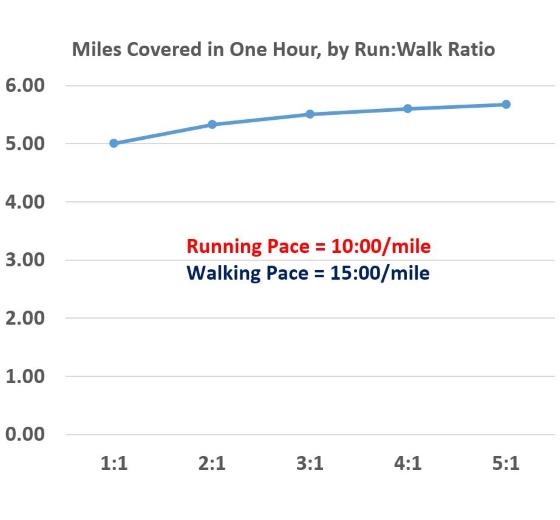An Hour with Five Run:Walk Methods
Have you ever wondered how different run:walk ratios affect the distance that you can cover in an hour?
As the author of Run:Walk Pace Tables in Minutes/Mile and its Minutes/Kilometer counterpart, I can help!
Divisors and Whole Numbers — Oh, My!
Let’s assume that you will run and walk for a total of one hour.
What’s nice about working with one hour is that dividing 60 minutes by the divisors 2, 3, 4, 5, or 6 gives us whole numbers.
Why do we care about these divisors? You’ll see in a moment.
The 1:1 method means that we run for 1 minute and walk for 1 minute. Yes, it can mean 43 seconds of running and 43 seconds of walking, as an extreme example. But, let’s go with whole minutes here.
The 2:1 method means that we run for 2 minutes and walk for 1 minute.
And so on.
Cycles, Not Bicycles
So, for one hour, you can think of:
- the 1:1 method as 30 cycles of 2 minutes each;
- the 2:1 method as 20 cycles of 3 minutes each;
- the 3:1 method as 15 cycles of 4 minutes each;
- the 4:1 method as 12 cycles of 5 minutes each;
- the 5:1 method as 10 cycles of 6 minutes each.
Put another way, in one hour:
- the 1:1 method = 30 minutes of running and 30 minutes of walking;
- the 2:1 method = 40 minutes of running and 20 minutes of walking;
- the 3:1 method = 45 minutes of running and 15 minutes of walking;
- the 4:1 method = 48 minutes of running and 12 minutes of walking;
- the 5:1 method = 50 minutes of running and 10 minutes of walking.
Pick Two
Now we need to know what running and walking paces to use to calculate how much distance we’ll cover in an hour.
I have two real-life paces that will make the arithmetic easy:
- I went for a six-mile walk yesterday and averaged 15:00/mile;
- I can average 10:00/mile on all-runs of around this distance.
Let’s use these two paces:
- 10:00/mile for running;
- 15:00/mile for walking.
How far can we go in 60 minutes with these paces and each run:walk ratio? Let’s do the arithmetic, one ratio at a time.
The 5:1 Method
50 minutes of running/(10:00/mile) = 5.00 miles.
10 minutes of walking/(15:00/mile) = 0.67 miles.
Total = 5.67 miles.
The 4:1 Method
48 minutes of running/(10:00/mile) = 4.80 miles.
12 minutes of walking/(15:00/mile) = 0.80 miles.
Total = 5.60 miles.
The 3:1 Method
45 minutes of running/(10:00/mile) = 4.50 miles.
15 minutes of walking/(15:00/mile) = 1.00 miles.
Total = 5.50 miles.
The 2:1 Method
40 minutes of running/(10:00/mile) = 4.00 miles.
20 minutes of walking/(15:00/mile) = 1.33 miles.
Total = 5.33 miles.
The 1:1 Method
30 minutes of running/(10:00/mile) = 3.00 miles.
30 minutes of walking/(15:00/mile) = 2.00 miles.
Total = 5.00 miles.
Comparing Methods

All five methods let us cover 5.00+ miles in one hour with the 10:00/mile running pace and the 15:00/mile walking pace.
The most dramatic difference in distance covered comes from switching from the 1:1 method to the 5:1 method. The latter puts us 0.67 miles further down the road.
But, suppose that we switch from the 1:1 method to the 2:1 method. The latter puts us 0.33 miles further down the road.
The least dramatic difference comes from switching from the 4:1 method to the 5:1 method. The latter puts us only 0.07 miles further down the road.
Choosing a Run:Walk Ratio
Which run:walk ratio should you use?
If you walk without a heavy heel-strike and can lose some distance, then downshift to a smaller ratio. You will get to walk more.
If you are a Pose-Method runner and want to cover extra distance, then upshift to a larger ratio. You will heel-strike less, which can be easier on your body.
If you get winded in the running phase, then you have two options. Choose either or both:
- Slow down your running pace.
- Shorten the running phase, and shorten the walking phase to maintain the same run:walk ratio.
If you enjoy running faster but for shorter durations, then do these together:
- Speed up your running pace.
- Shorten the running phase, and shorten the walking phase to maintain the same run:walk ratio.
What’s 7/100ths of a Mile Between Friends?
As noted, going from 5:1 to 4:1 without changing the above paces means that you’d lose only 7/100ths of a mile in an hour.
Two questions:
- Is 7/100ths of a mile that important to you?
- Do you see that a 20% shorter running phase could let you run so much faster that you’d more than make up the 7/100ths of a mile?
Would You Like 1/3rd of a Mile More?
Going from 1:1 to 2:1 without changing the above paces means that you’d be 1/3rd of a mile further down the road in an hour.
Two questions:
- Is that kind of mileage gain attractive?
- Can you handle a 100% longer running phase?
Only You Know
Only you know what’s best for you. My book Run:Walk Method Mastery can help you to choose the right run:walk ratio for you. But, you have to experiment to find the right ratio with the right durations and the right paces.
What Say You?
Have you experimented with your run:walk workouts? What has worked best for you? Post a comment here!